ZTE Maven 2 User Guide

User Guide

Copyright © 2017 ZTE CORPORATION. All rights reserved. ZTE, Maven, and the ZTE logos are trademarks of the ZTE Corporation. AT&T, the AT&T logo and all other AT&T marks contained herein are trademarks of AT&T Intellectual Property and/or AT&T.
No part of this publication may be excerpted, reproduced, translated or utilized in any form or by any means, electronic or mechanical, including photocopying and microfilm, without the prior written permission of
ZTE Corporation.
The manual is published by ZTE Corporation. We reserve the right to make modifications on print errors or update specifications without prior notice.
microSDHC is a trademark of SD-3C LLC. The Bluetooth® word mark and logos are registered trademarks owned by Bluetooth SIG, Inc.
Manufactured under license from Dolby Laboratories. Dolby, Dolby Audio, and the double-D symbol are trademarks of Dolby Laboratories. Qualcomm and Snapdragon are trademarks of Qualcomm Incorporated, registered in the United States and other countries. Used with permission.
Version No. : V2.0
Edition Time: August 2017
Contents
Getting Started. . . . . . . . . . . . . . . . . . . . . . . . . .7
Installing the Nano-SIM Card and the Battery. . . . . . . . |
|
7 |
Installing a microSDHC Card. . . . . . . . . . . . . . . . . |
|
8 |
Charging the Battery. . . . . . . . . . . . . . . . . . . . |
. |
8 |
Extending the Battery Life. . . . . . . . . . . . . . . . . |
. |
9 |
Powering Your Phone On/Off. . . . . . . . . . . . . . . . |
|
. 9 |
Setting Up Your Phone for the First Time. . . . . . . . . . |
|
10 |
Locking/Unlocking the Screen and Keys. . . . . . . . . . |
. 10 |
|
Using the Touch Screen. . . . . . . . . . . . . . . . . . . |
|
. 11 |
Getting to Know Your Phone.. . . . . . . . . . . . . . . . |
|
13 |
Key Functions. . . . . . . . . . . . . . . . . . . . . . . . . . . . . . . . . . . . . . . . . . . . . . . |
. |
14 |
Getting to Know the Home Screen. . . . . . . . . . . . . |
|
15 |
Personalizing. . . . . . . . . . . . . . . . . . . . . . . . . . |
|
17 |
Changing the System Language . . . . . . . . . . . . . . |
. |
17 |
Setting the Date and Time. . . . . . . . . . . . . . . . . |
. |
17 |
Changing the Ringtone and Notification Sound. . . . . . . . . . . . |
. |
18 |
Turning System Sounds On/Off. . . . . . . . . . . . . . |
|
18 |
Adjusting Volumes. . . . . . . . . . . . . . . . . . . . . . . . . . . . . . . . . . . . . . . . . . |
. |
19 |
Switching to Silent or Vibration Mode. . . . . . . . . . . . . . . . . . . . . . . |
|
19 |
Using Do Not Disturb Mode . . . . . . . . . . . . . . . . . |
|
20 |
Applying New Wallpapers. . . . . . . . . . . . . . . . . . |
|
21 |
Setting the Theme . . . . . . . . . . . . . . . . . . . . . |
. |
21 |
Setting the Home Screen Transition Effect. . . . . . . . . |
|
22 |
Changing the Screen Brightness. . . . . . . . . . . . . . |
. |
22 |
CONTENTS |
1 |
Protecting Your Phone With Screen Locks.. . . . |
. . . . . |
|
22 |
Protecting Your Phone With Screen Pinning. . |
. . . . . . |
. |
23 |
Knowing the Basics. . . . . . . . . . . . . . . . |
. . . . . . . |
25 |
|
Monitoring the Phone Status. . . . . . . . . . . . . . . . |
|
|
25 |
Managing Notifications. . . . . . . . . . . . . . . . . . . |
|
|
26 |
Managing Shortcuts and Widgets. . . . . . . . |
. . . . . . |
|
30 |
Organizing With Folders. . . . . . . . . . . . . |
. . . . . . |
|
30 |
Rearranging the Primary Shortcuts. . . . . . . |
. . . . . . |
|
31 |
Entering Text. . . . . . . . . . . . . . . . . . |
. . . . . . . |
31 |
|
Editing Text. . . . . . . . . . . . . . . . . . . . . . . . . |
|
|
34 |
Opening and Switching Apps.. . . . . . . . . . . . . . . . |
|
|
35 |
Connecting to Networks and Devices. . . . . . . . . . . |
. |
|
37 |
Connecting to Mobile Networks. . . . . . . . . . . . . . |
|
|
37 |
Connecting to Wi-Fi®. . . . . . . . . . . . . . . . . . . . |
|
|
38 |
Connecting to Bluetooth® Devices. . . . . . . . . . . . . . |
. . . . . . . . . . . . |
. |
42 |
Connecting to Your Computer via USB. . . . . |
. . . . . . |
|
44 |
Using the microSDHC Card as Portable or |
|
|
|
Internal Storage. . . . . . . . . . . . . . . . . |
. . . . . . |
|
46 |
Sharing Your Mobile Data Connection. . . . . |
. . . . . . |
. 49 |
|
Connecting to Virtual Private Networks. . . . |
. . . . . . . |
51 |
|
Phone Calls.. . . . . . . . . . . . . . . . . . . . . . . . . . |
|
|
53 |
Placing and Ending Calls. . . . . . . . . . . . . |
. . . . . . |
|
53 |
Answering or Rejecting Calls. . . . . . . . . . |
. . . . . . |
. |
54 |
Working With the Call History. . . . . . . . . . |
. . . . . . |
|
55 |
Calling Your Contacts. . . . . . . . . . . . . . |
. . . . . . |
|
55 |
2 |
CONTENTS |
Checking Voicemail. . . . . . . . . . |
. . |
. . |
. . . . . . . |
|
|
|
56 |
Using Options During a Call . |
. |
. . . . . . . . . |
. |
. . . . . |
|
56 |
|
Managing Multi-party Calls. . . . . . . . . . . |
. . . . . . |
. 57 |
|||||
Adjusting Your Call Settings.. |
. . |
. . |
. . . . . . . . . . . |
|
|
|
58 |
Contacts. . . . . . . . . . . . . . . . . . . . . . . . |
. . |
. . |
. . . . . . . . . . . . . . . |
. . |
. . . . . . . . . . |
. |
64 |
Checking Contact Details . . |
. . . . . . . . . . |
. . . . . . |
|
64 |
|||
Adding a New Contact. . . . . . . |
. . |
. . |
. . . . . . . . |
|
|
|
64 |
Setting Up Your Own Profile. |
. |
. . . . . . . . |
. |
. . . . . |
. |
65 |
|
Importing, Exporting, and Sharing Contacts. . |
. |
. . . . . |
. 65 |
||||
Working With Favorite Contacts. |
. . . . . . . |
. |
. . . . . |
. 66 |
|||
Working With Groups.. . . . . . . . . . . . . . |
. |
. . . . . |
|
67 |
|||
Searching for a Contact. . . . . . . . . . . . . |
. |
. . . . . 68 |
|||||
Editing Contacts.. . . . . . . . . . . . . . . . |
. |
. . . . . |
|
68 |
|||
Accounts. . . . . . . . . . . . . . . . . . . . . . . . . . . . .71 |
|||||||
Adding or Removing Accounts. . . . . . . . . |
. . . . . . |
. |
71 |
||||
Configuring Account Sync. . . |
. . |
. . |
. . . . . . . . . . |
|
|
|
72 |
Email. . . . . . . . . . . . . . . . . . . . . . . . . . . . . . |
|
|
|
|
|
|
74 |
Setting Up the First Email Account.. . . . . . . |
. |
. . . . . |
|
74 |
|||
Writing and Sending an Email . . |
|
. . . . . . . . |
. . . . . . |
|
74 |
||
Checking Your Email. . . . . . . . . |
. . |
. . |
. . . . . . . |
|
|
|
75 |
Responding to an Email . . . . . . . . . . . . . |
. |
. . . . . |
|
75 |
|||
Adding a Signature to Your Emails. . . . . . . |
. |
. . . . . |
. |
76 |
|||
Adding, Editing, or Deleting an Email Account . |
. |
. . . . . . 77 |
|||||
Changing General Email Settings. |
. . . . . . . . . . . . . |
|
|
|
78 |
||
CONTENTS |
3 |
Messaging.. . . . . . . . . . . . . . . . . . . . . . . . . . . |
79 |
Opening the Messaging Screen. . . . . . . . . . . . . . . |
79 |
Sending a Message. . . . . . . . . . . . . . . . . . . . . |
. 79 |
Replying to a Message. . . . . . . . . . . . . . . . . . . |
80 |
Deleting Messages or Threads. . . . . . . . . . . . . . . |
. 80 |
Forwarding a Message. . . . . . . . . . . . . . . . . . . . . . . . . . . . . . . . . . . . . . |
. 81 |
Changing Message Settings.. . . . . . . . . . . . . . . . |
81 |
Calendar. . . . . . . . . . . . . . . . . . . . . . . . . . . . |
82 |
Viewing Your Calendars and Events.. . . . . . . . . . . . |
82 |
Creating an Event . . . . . . . . . . . . . . . . . . . . . . |
83 |
Editing, Deleting, or Sharing an Event. . . . . . . . . . . . |
83 |
Changing Calendar Settings. . . . . . . . . . . . . . . . |
84 |
Searching an Event. . . . . . . . . . . . . . . . . . . . . |
. 84 |
Browser. . . . . . . . . . . . . . . . . . . . . . . . . . . . . 85 |
|
Opening the Browser.. . . . . . . . . . . . . . . . . . . . |
85 |
Using Multiple Browser Tabs. . . . . . . . . . . . . . . . |
. 85 |
Downloading Files. . . . . . . . . . . . . . . . . . . . . . |
86 |
Changing Browser Settings. . . . . . . . . . . . . . . . . |
86 |
Camera. . . . . . . . . . . . . . . . . . . . . . . . . . . . . |
87 |
Capturing a Photo. . . . . . . . . . . . . . . . . . . . . . |
87 |
Using Manual Camera Mode. . . . . . . . . . . . . . . . |
89 |
Recording a Video. . . . . . . . . . . . . . . . . . . . . . |
90 |
Customizing Camera and Video Settings. . . . . . . . . . |
90 |
4 |
CONTENTS |
Gallery.. . . . . . . . . . . . . . . . . . . . . . . . . . . . . |
|
92 |
Opening the Gallery. . . . . . . . . . . . . . . . . . . . |
. |
92 |
Working With Albums. . . . . . . . . . . . . . . . . . . . |
|
92 |
Working With Pictures. . . . . . . . . . . . . . . . . . . |
. |
93 |
Playing Videos. . . . . . . . . . . . . . . . . . . . . . . |
. |
96 |
Music. . . . . . . . . . . . . . . . . . . . . . . . . . . . . |
. |
97 |
Copying Music Files to Your Phone.. . . . . . . . . . . . . |
|
97 |
Viewing Your Music Library.. . . . . . . . . . . . . . . . . |
|
98 |
Setting a Song as the Default Ringtone.. . . . . . . . . . |
|
98 |
Playing Music. . . . . . . . . . . . . . . . . . . . . . . . |
|
. 99 |
Managing Playlists.. . . . . . . . . . . . . . . . . . . . . 100 |
||
Video Player. . . . . . . . . . . . . . . . . . . . . . . . . |
|
101 |
Opening the Video Library. . . . . . . . . . . . . . . . . . . . . . . . . . . . . . . . . |
. |
101 |
Playing and Controlling Videos. . . . . . . . . . . . . . . |
|
101 |
Managing Video Files. . . . . . . . . . . . . . . . . . . . |
|
102 |
More Apps. . . . . . . . . . . . . . . . . . . . . . . . . . |
|
104 |
Backup & Restore. . . . . . . . . . . . . . . . . . . . . . . . . . . . . . . . . . . . . . . . . . |
. |
104 |
Calculator. . . . . . . . . . . . . . . . . . . . . . . . . |
|
104 |
Clock. . . . . . . . . . . . . . . . . . . . . . . . . . . . |
|
104 |
Downloads. . . . . . . . . . . . . . . . . . . . . . . . . |
|
105 |
File Manager. . . . . . . . . . . . . . . . . . . . . . . . . 105 |
||
Sound Recorder. . . . . . . . . . . . . . . . . . . . . . |
. 106 |
|
Google Apps. . . . . . . . . . . . . . . . . . . . . . . . |
. |
107 |
CONTENTS |
5 |
Settings. . . . . . . . . . . . . . . . . . . . . . . . . . . . 109
Wireless & Networks. . . . . . . . . . . . . |
. . . . . . . . . . . . . . . . . . . . . . . . . . |
. |
109 |
||
Device . . |
. . . . . . . . . . . . . . . . . . . . . . . . . |
. |
111 |
||
Personal. . . . . . . . . . . . . . . . . . . . . . . . . . |
. |
115 |
|||
System . . |
. . . . . . . . . . . . . . . . . . . . . . . . . |
|
.119 |
||
Upgrading the Phone Software. . . . . . . . . . . . . . . |
. |
120 |
|||
Troubleshooting. . . . . . . . . . . . . . . . . . . . . . . . 121 |
|||||
For Your Safety . . |
. . . . . . . . . . . . . . . . . . . . . . |
|
124 |
||
General Safety Information. . . . . . . . . . . . . . . . |
. |
124 |
|||
FCC Regulations. . . . . . . . . . . . . . . . . . . . . . |
. |
125 |
|||
RF Exposure Information (SAR). |
. . . . . . . . . . . . . |
. |
126 |
||
Hearing Aid Compatibility (HAC) Regulations |
|
|
|||
for Mobile Phones. . . . . . . . . . . . . . . . . . . . . |
. |
127 |
|||
CTIA. . . . . . |
. . . . . . . |
. . . . . . . . . . . . . . . |
|
|
129 |
Distraction. . . . . . |
. . . . . . . . . . . . . . . |
. . . . |
|
130 |
|
Product Handling. . . . . . . . . . . . . . . . . . . . . . |
|
130 |
|||
Electrical Safety. . . . . . . . . . . . . . . . . . . . . . |
. |
133 |
|||
Interference. . . . . . . . . . . . . . . . . . . . . . . . |
. 134 |
||||
Explosive Environments. . . . . . . . . . . . . . . . . . |
. 136 |
||||
Warranty. . . . . . . . . . . . . . . . . . . . . . . . . . . . 137 |
|||||
Limited Warranty. . . . . . . . . . . . . . . . . . . . . . |
|
138 |
|||
How to Get Warranty Service. . |
. . . . . . . . . . . . . |
. |
139 |
||
Other Warranty Programs. . . . . . . |
. . . . . . . . . . |
|
139 |
||
Specifications. . . . . . . . . . . . . . . . . . . . . . . . . |
|
140 |
|||
6 |
CONTENTS |

Getting Started
Installing the Nano-SIM Card and the Battery
Power off your phone before installing or replacing the nano-SIM card.
1.Insert your fingernail into the slot at the bottom left of the back cover, and lift it up gently.
2.Hold the nano-SIM card with the cut corner oriented as shown, and slide it into the card slot.
Important: To avoid damage to the phone, do not use other kinds of SIM cards or a non-standard nano-SIM card cut from a
SIM card. You can obtain a standard nano-SIM card from your service provider.
3.Insert the battery by aligning the metal contacts on the battery with the metal contacts in the battery compartment.
Gently push down on the battery until it clicks into place.
4.Align the back cover with the back of the phone, and press the cover back into place. Make sure all the tabs are secure and there are no gaps around the cover.
GETTING STARTED |
7 |

Installing a microSDHC Card (not included)
The microSDHC card can be installed and removed while the phone is powered on. Unmount the microSDHC card before removing or replacing it.
1.Remove the back cover.
2.Hold your microSDHC card with the metal contacts facing down, and slide it into the card slot.
Note: Some applications may require a microSDHC card to work normally, or may store certain data on it.
Therefore, it is recommended that you keep a microSDHC card installed and not remove or replace it randomly.
3.Press the back cover gently back into place until you hear a click.
Charging the Battery
Your phone’s battery should have enough power for the phone to turn on, find a signal, and make a few calls. You should fully charge the battery as soon as possible.
If the battery is low, there will be a pop-up message on the screen. As you charge your phone, the screen will show you the exact battery level each time you wake up your phone.
Note: To charge your ZTE Maven 2, you must use the USB cable and connector that is included with your phone. The ZTE Maven 2 cannot be charged with a standard micro-USB charger.
Warning! Use only ZTE-approved chargers and cables. The use of unapproved accessories could damage your phone or cause the battery to explode.
8 |
GETTING STARTED |

1.Connect the adapter to the charging port.
2.Connect the charger to a standard AC wall outlet. If the phone is on, you’ll see a
charging icon, such as  or
or  , appear in the
, appear in the
Status Bar.
3.Disconnect the charger when the battery is fully charged.
Note: If the battery is extremely low, you may be unable to power on the phone even when it is being charged. In this case, try again after charging the phone
for at least 20 minutes. Contact customer service if you still cannot power on the phone after prolonged charging.
Extending the Battery Life
Active applications, screen brightness levels, Bluetooth and Wi-Fi usage, and GPS functionality can drain your battery. You can follow the helpful tips below to conserve your battery power:
•Reduce the screen backlight time.
•Lower the screen brightness.
•Turn auto-sync, Wi-Fi, andBluetooth off when not in use.
•Disable the GPS function when not in use. Most applications using this function will periodically query the GPS satellites for your current location; each query drains your battery.
Powering Your Phone On/Off
•Press and hold the Power key to power on your phone.
•To turn it off, press and hold thePower key to open the options menu. Tap Power off.
GETTING STARTED |
9 |
Note: If the phone freezes or takes too long to respond, press and hold the Power key for about 10 seconds to restart the phone.
Setting Up Your Phone for the First Time
When you first power on your phone after you purchase it or reset it to factory settings (seeSettings – Personal – Backup & Reset), you will need to set it up before using it.
Tap the language field to select a language. Then tapLET’S GO and follow the prompts to set up your Wi-Fi connection, Google services, name, device protection, and other options.
Note: Users with low vision can tapVision Settings on the initial setup screen to customize accessibility features.
Locking/Unlocking the Screen and Keys
Your phone allows you to quickly lock the screen and keys (put the phone into Sleep mode) when not in use and also to turn the screen back on and unlock it when you need it.
Locking the Screen and Keys
To quickly turn the screen off and lock the keys, press the
Power key.
Note: To save battery power, the phone automatically turns off the screen after a certain period of time when you leave it idle. You will still be able to receive messages and calls while the phone screen is off.
Unlocking the Screen and Keys
1. Press the Power key to turn the screen on.
10 |
GETTING STARTED |
2.Press and hold a blank area of the screen or  to wake the phone, or
to wake the phone, or
•Press and hold  to use Google voice commands.
to use Google voice commands.
•Press and hold  to open the front camera.
to open the front camera.
•Double-tap a notification to open the related app.
Note: If you have set an unlock pattern, PIN, or password for your phone (seePersonalizing – Protecting Your Phone With Screen Locks), you’ll need to draw the pattern or enter the PIN/ Password to unlock your screen.
Using the Touch Screen
Your phone’s touch screen lets you control actions through a variety of touch gestures.
•Tap – When you want to type using the on-screen keyboard, select on-screen items (such as application and settings icons), or press on-screen buttons, simply tap them with your finger.
•Press and Hold – To open the available options for an item
(for example, a message or link in a web page), press and hold the item.
•Swipe or Slide – To swipe or slide means to quickly drag your finger vertically or horizontally across the screen.
•Drag – To drag, press and hold your finger with some pressure before you start to move your finger. While dragging, do not release your finger until you have reached the target position.
•Pinch – In some apps (such as Maps and Browser), you can zoom in and out by placing two fingers on the screen at once and pinching them together (to zoom out) or spreading them apart (to zoom in).
GETTING STARTED |
11 |

•Rotate the Screen – For most screens, you can automatically change the screen orientation from portrait to landscape by turning the phone sideways.
Notes:
•The Auto-rotate feature needs to be enabled for the screen orientation to automatically change. From the
home screen, tap  Settings Display When device is rotated Rotate the contents of the screen.
Settings Display When device is rotated Rotate the contents of the screen.
•You can also access the screen rotation control by sliding down the Status Bar twice and tappingAuto-rotate or Portrait.
12 |
GETTING STARTED |
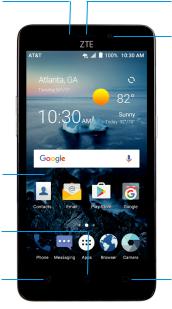
Getting to Know Your Phone
Indicator 
light
Proximity and 
light sensor
Volume key 
Touch  screen
screen
Home key 
Back key 
Charging/ 
USB port
 Earpiece
Earpiece
 Front camera
Front camera
 Power key
Power key
 Recent
Recent
apps key
GETTING STARTED |
13 |
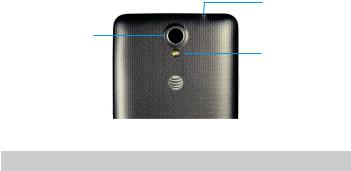
(Back)
 3.5 mm headset port
3.5 mm headset port
Back camera 
 Flash
Flash
Key Functions
Key |
Function |
|
|
|
|
|
Press and hold to turn Airplane mode on or off, restart, |
|
Power key |
or power off. |
|
Press to change your phone to Sleep mode. |
||
|
||
|
Press to wake up your phone. |
|
|
|
|
|
Press to return to the home screen from any |
|
Home key |
application or screen. |
|
|
Press and hold to access the Google app. |
|
|
|
|
|
Press to see recently used applications. |
|
Recent apps |
Double-tap to switch to the most recent application. |
|
key |
Press and hold to activate split-screen mode (see |
|
Knowing the Basics – Opening and Switching Apps – |
||
|
||
|
Using Two Apps in Split-Screen Mode). |
|
|
|
|
Back key |
Press to go to the previous screen. |
|
|
|
|
Volume key |
Press or hold to turn the volume up or down. |
|
|
|
|
14 |
GETTING STARTED |
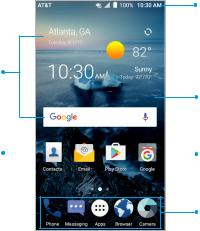
Getting to Know the Home Screen
The home screen is the starting point for your phone’s applications, functions, and menus. You can customize your home screen by adding shortcuts, folders, widgets, and more.
Status and
notificationbar
Widgets
Wallpaper
Shortcut |
|
|
|
Folder |
|
|
|||
|
Primary shortcuts
Extending the Home Screen
Your home screen is extendable, providing more space for shortcuts, widgets, and more. Simply swipe your finger to the left or right to see the extended home screen panels. You can add or remove home screen panels or adjust the order.
GETTING STARTED |
15 |
Adding a New Home Screen Panel:
1.Press and hold an empty area of the home screen.
2.Swipe left or right through the home screen thumbnails until you see  . Tap
. Tap  to create a new home screen panel.
to create a new home screen panel.
Deleting a Home Screen Panel:
1.Press and hold an empty area of the home screen.
2.Swipe left or right to view the home screen thumbnails.
Tap  on the top right corner of a thumbnail.
on the top right corner of a thumbnail.
3.Tap OK. The items on the panel will also be removed.
Note: There must be at least three home screen panels.
Moving a Home Screen Panel:
1.Press and hold an empty area of the home screen.
2.Swipe left or right to view the home screen thumbnails. Press and hold a thumbnail and drag it left or right to the place you need.
Note: Tap  at the bottom of a home screen thumbnail to set it as the main home screen.
at the bottom of a home screen thumbnail to set it as the main home screen.
16 |
GETTING STARTED |

Personalizing
Changing the System Language
1. From the home screen, tap |
Settings Languages & |
input Languages. |
|
2.To add a system language, tap Add a language and then the language you need.
3.Press and hold a language and move it to the top to switch to that language.
Setting the Date and Time
1.From the home screen, tap Settings
Settings Date & time.
Date & time.
2.Set the date, time, time zone, and time format.
•To adjust the date and time automatically, tap to turn on
Automatic date & time.
•To adjust the date and time manually, tap to turn off
Automatic date & time and tap Set date / Set time to change the date and time.
•To adjust the time zone automatically, tap to turn on
Automatic time zone.
•To adjust the time zone manually, tap to turn offAutomatic time zone and tap Select time zone to set the correct time zone.
•To adjust the time format, tap Use 24-hour format.
PERSONALIZING |
17 |

Changing the Ringtone and
Notification Sound
You can customize the default ringtone for incoming calls, the default notification sound, and the default alarm ringtone.
1.From the home screen, tap Settings
Settings Sound.
Sound.
2.Tap Phone ringtone, Default notification ringtone, or Default alarm ringtone.
3.Scroll through the list and select the ringtone you’d like to use.
4.Tap OK.
Notes:
•Many applications have their own notification sound settings.
•See Contacts – Editing Contacts – Setting a Ringtone for a Contact for how to assign a special ringtone to an individual contact.
•When selecting ringtones or sounds, tap the Music or
Recording tab to select an audio file saved on the phone or the memory card.
Turning System Sounds On/Off
1. From the home screen, tap |
Settings Sound |
Other sounds. |
|
2.Tap Dial pad tones, Screen locking sounds, Charging sounds, Touch sounds, Vibrate on tap, or Power up tone to turn these options on or off.
18 |
PERSONALIZING |

Adjusting Volumes
1.From the home screen, tap Settings
Settings Sound.
Sound.
2.Drag the sliders belowMedia volume, Alarm volume, Ring volume, and Notification volume to adjust the volume for each type of audio.
Note: You can adjust the media volume when a media application is in use by pressing the Volume key. If no media application is active, press the Volume key to adjust ringtone volume (or the earpiece volume during a call).
Switching to Silent or Vibration Mode
You can set the phone to silent or vibration mode using one of the following methods:
•Press the Volume key when no media application is active to show the volume management window. Drag the slider to the left or press and hold the lower end of theVolume key to switch the phone to vibration mode. Press down on the Volume key again in vibration mode to switch the phone to silent mode.
• From the home screen, tap Settings Sound
Settings Sound
Notification mode and select Vibrate or Mute to switch to vibration or silent mode.
Note: Silent and vibration modes will not silence your alarm sound.
PERSONALIZING |
19 |

Using Do Not Disturb Mode
You can limit interruptions with Do not disturb mode. This mode silences your phone so that it doesn’t make sounds or vibrate when you don’t want it to.
1. From the home screen, tap |
Settings Sound Do |
not disturb. |
|
2.Tap Do not disturb and select On or Scheduled as you need.
•Tap On to turn on Do not disturb mode immediately. It will remain on until you turn it off.
•Tap Scheduled to select time periods for Do not disturb mode to be turned on automatically.
3.Set the detailed settings.
•If you have selected Scheduled, tap Days, Start time, or
End time to specify the time periods during which Do not disturb mode is on.
•Tap Disturb rules to choose whether you’d like to allow certain notifications or not.
–Priority only: Only notifications you have marked as priority are allowed.
–Alarms only: Only alarms are allowed.
–Total silence: No notifications are allowed.
•If you have selected Priority only, you can customize the types of allowed sounds or vibrations under Priority
interruptions. Tap the switches next to the items you want to allow. TapMessages or Calls to set preferences for which messages and calls will be allowed.
20 |
PERSONALIZING |

Notes:
•To turn off Do not disturb mode quickly, press theVolume key and tap END NOW.
•Do not disturb mode will not silence your alarms unless you select Total silence.
•To set exceptions based on apps, from the home screen, tap
Settings Notifications. Select an app and tap to turn on
Override Do Not Disturb.
Applying New Wallpapers
You can set the wallpaper for the home screen and lock screen.
1.Press and hold an empty area of the home screen.
2.Tap Wallpapers.
3.Swipe left or right on the wallpaper panel to select a wallpaper, or tap GALLERY or LIVE WALLPAPER to choose the image or animation you want to use.
Note: In addition, from the home screen, you can tap 
Settings Display Wallpaper to pick an image from Gallery,
Photos, or Wallpapers or an animation from Live Wallpapers.
Setting the Theme
1.Press and hold an empty area of the home screen.
2.Tap Themes.
3.Tap a theme to select it.
PERSONALIZING |
21 |

Setting the Home Screen Transition Effect
1.Press and hold an empty area of the home screen.
2.Tap Effects.
3.Tap an effect, and the phone will demonstrate how it works. Tap other effects until you find your favorite one.
Changing the Screen Brightness
1. From the home screen, tap |
Settings Display |
Brightness level. |
|
2. Drag the slider to manually adjust the screen brightness.
Note: Your phone can automatically adjust the screen brightness for available light. Tap Adaptive brightness in the Display settings screen to turn the feature on or off.
Protecting Your Phone With Screen Locks
You can protect your phone by creating a screen lock. When enabled, you need to press and hold on the lock screen, and then draw a pattern or enter a numeric PIN or a password to unlock the phone’s screen and keys.
1. From the home screen, tap |
Settings Security |
Screen lock. |
|
2.Tap None, Long press, Pattern, PIN, or Password.
•Tap None to disable screen lock protection.
•Tap Long press to enable screen lock and allow unlocking with a “press and hold” gesture. You can unlock the screen by pressing and holding a blank area on the lock screen.
22 |
PERSONALIZING |

•Tap Pattern to create a pattern that you must draw to unlock the screen.
•Tap PIN or Password to set a numeric PIN or a password that you must enter to unlock the screen.
3.For Pattern, PIN, or Password lock, select whether or not to require it to start the device.
Note: When this feature is enabled, your phone cannot receive calls, messages, or notifications, including alarms, until it starts up.
4.For Pattern, PIN, or Password lock, select how you would like notifications and their contents to show when the phone is locked, and then tap DONE.
Note: Remember the pattern, PIN, or password you set. Otherwise, you will need to upgrade the phone software to use the phone.
Protecting Your Phone With Screen Pinning
You can use the screen pinning feature to keep an app in view, so others cannot switch to other apps or access your personal information.
Turning On Screen Pinning
1. From the home screen, tap |
Settings Security |
Screen pinning. |
|
2.Tap the On/Off switch.
3.If you want to be asked for the unlock pattern, PIN, or password before unpinning the screen, switch onAsk for unlock pattern / PIN / password before.. when the screen lock has been set.
PERSONALIZING |
23 |
Pinning a Screen
1.Ensure that screen pinning is turned on.
2.Open the app you want to keep in view.
3.Press the Recent apps key.
4.If there are many app tabs, swipe up to find  on the frontmost tab.
on the frontmost tab.
5.Tap  GOT IT.
GOT IT.
Unpinning the Screen
To unpin the screen and return to normal use, press and hold the
Back key.
If you have turned on Ask for unlock pattern / PIN / password before.., press and hold on the lock screen and draw the pattern or enter the PIN/password.
24 |
PERSONALIZING |
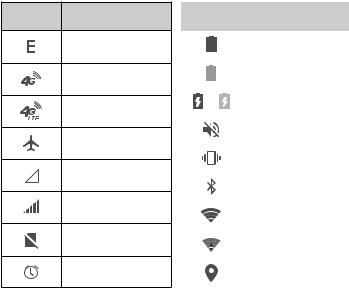
Knowing the Basics
Monitoring the Phone Status
The Status Bar at the top of the home screen provides phone and service status icons on the right side. Below are some of the icons you may see.
Indicator What it means
EDGE connected
3G connected
4G LTE™ connected
Airplane mode
No signal
Signal strength
No nano-SIM card installed
Alarm set
Indicator |
What it means |
||||||
|
|
|
|
|
|
|
|
|
|
|
|
|
|
|
Battery low |
|
|
|
|
|
|
|
|
|
|
|
|
|
|
|
Battery full |
|
|
|
|
|
|
|
|
/ |
|
Battery charging |
|||||
|
|
|
|
|
|
|
|
|
|
|
|
|
|
|
Silent mode |
|
|
|
|
|
|
|
|
|
|
|
|
|
|
|
Vibration mode |
|
|
|
|
|
|
|
|
|
|
|
|
|
|
|
Bluetooth on |
|
|
|
|
|
|
|
|
|
|
|
|
|
|
|
Connected to a |
|
|
|
|
|
|
|
Wi-Fi network |
|
|
|
|
|
|
|
|
|
|
|
|
|
|
|
Wi-Fi in use |
|
|
|
|
|
|
|
|
|
|
|
|
|
|
|
GPS on |
|
|
|
|
|
|
|
|
KNOWING THE BASICS |
25 |
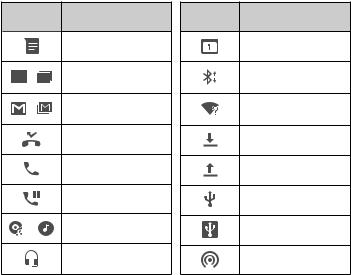
Managing Notifications
The Status Bar at the top of the home screen provides notification icons on the left side. Below are some of the icons you may see.
Indicator |
What it means |
|
New message |
/ |
New Email |
|
message(s) |
/ |
New Gmail™ |
|
message(s) |
|
Missed call |
|
Call in progress |
|
Call on hold |
/ |
Song playing |
|
Wired headset |
|
connected |
26 |
|
Indicator What it means
Upcoming event
Incoming file via
Bluetooth
New Wi-Fi network detected
Downloading data
Sending data
USB connected
USB tethering on
Mobile hotspot on
KNOWING THE BASICS

Opening/Closing the Notification Panel
Notifications report the arrival of new messages, calendar events, and alarms, as well as ongoing events, such as when music is playing. You can open the Notification Panel to view the details of notifications.
•To open the Notification Panel, swipe your finger down on the home screen or from the top of the screen.
•To close the Notification Panel, swipe your finger up on the screen or press the Back key.
Responding to or Removing a Notification
In the Notification Panel, you can respond to or remove notifications. The Notification Panel also supports expandable notifications that let you perform additional actions right from the notification itself.
•To respond to a notification, tap it.
•Swipe down with one finger to expand certain notifications. You also swipe two fingers vertically or pinch-zoom to expand or collapse certain notifications.
•To remove a notification, swipe it left or right.
•To remove all notifications, tapCLEAR ALL at the end of the list of notifications.
•To manage notifications you have received, press and hold a notification. You can then tapShow notifications silently DONE to show notifications silently, or tapMORE SETTINGS to configure other notification options for this app.
KNOWING THE BASICS |
27 |
Note: If you block notifications for an app, you may miss its important alerts and updates. The notifications of some apps cannot be blocked.
Using Quick Settings
The Quick Settings in the Notification Panel make it convenient to view or change the most common settings for your phone.
Swipe down with two fingers from the top of the screen, or open the Notification Panel and drag the panel downward to view the following Quick Settings; swipe left for more.
Note: On the Quick Settings screen, tap  at the top to open the Settings menu, or tap
at the top to open the Settings menu, or tap  to add, remove, or rearrange Quick Settings icons.
to add, remove, or rearrange Quick Settings icons.
•Brightness: Uncheck AUTO and drag the brightness slider to adjust the screen brightness.
•Bluetooth: Tap to turn Bluetooth on or off. Press and hold to open the Bluetooth menu. (SeeConnecting to Networks and Devices – Connecting to Bluetooth Devices.)
•Wi-Fi: Tap to turn Wi-Fi on or off. Press and hold to open the Wi-Fi menu. (SeeConnecting to Networks and Devices – Connecting to Wi-Fi.)
•Data: Tap to turn mobile data on or off. Press and hold to open the Data usage menu. (SeeSettings – Wireless & Networks – Data Usage.)
•Location: Tap to turn Location on or off. Press and hold to open the Location menu. (SeeSettings – Personal – Location.)
•Airplane mode: Tap to turn Airplane mode on or off. Press and hold to access additional network settings.
•Flashlight: Tap to turn the flashlight on or off.
28 |
KNOWING THE BASICS |
